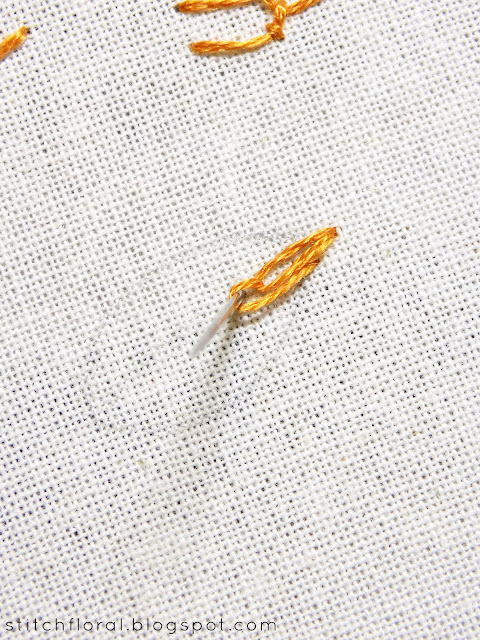New month, new stitches! Today and few next days let's take a look at cretan stitch and some of its variations as well as herringbone stitch and romanian couching. I tried to group them together based on the fact that they are often used in crewel embroidery as a filling technique and also they are quite popular for working leaves and similar shapes.
Cretan stitch will be quite easy to conquer if you are already familiar with fly stitch and feather stitch because the technique is very similar. So if you forgot them, it's time to refresh your memory and make few practice stitches.
Where to apply cretan stitch?
From what I noticed, it is a very popular way to work leaves, especially in crewel embroidery. And I actually like using it for this purpose as well! You can see my cretan leaves in this design - they turn out having satin stitch-resemblant sides and braided dimensional “spine” which I think looks lovely. The only nuance is that it probably would work better with simple shaped leaves, you know, without the ragged sides.
Another way to apply cretan stitch is to work a border. Crazy quilting, anyone? Add some french knots or lazy daisy stitches on the tips of cretan stitch and it will make a pretty decorative border. You can also adjust cretan stitch's appearance by changing the place of the stitch points... well, it will be clearer after we take a look at how to actually work it.
How to work cretan stitch
First, we need to make a stitch from A to B. As you see, the B point is situated a bit lower than A. Next, bring the needle back to the front of the fabric through the point C, which is lower than B but closer to A.
From C we make a stitch ending at point D, which is, again, a bit lower. And come up through the fabric at point E. Note that both, in this step and the previous one, when we bring the needle up through the fabric, the stitch is under the needle.
I prefer the stabbing way of working cretan stitch, but you can also use a sewing method if you want. Just don't forget to keep the thread under the needle when you work it.
Here's how you change the look of cretan stitch, making it more open or close. Also, the points C and E from the first two pictures can be situated closer to the edges of the border, or they can be right under each other – all of these alterations will bring forward something new in this stitch.
Cretan stitch leaf
As much as I'm an advocate of fine embroidery and using primarily 1 strand of floss in the needle, I believe working cretan stitch will be best if you have at least 2 strands of floss, especially when you work leaves. Otherwise, it will a) take a really long time to fill a shape b) will be not as dimensional.
Also, I would like to warn, that my way of working cretan stitch is slightly different from the ones you will find in many other resources. So be aware of that and maybe check out some other places to know which method suits you better.
I start my cretan stitch leaves with a lazy daisy stitch on top of the shape. After that I make a stitch to one of the edges, coming back to the front right under the lazy daisy stitch (and making sure that the needle is inside the stitch).
Repeating the same actions, but now on the other side of the leaf. And the needle appears right on the line of the “spine” again.
So, here's how your cretan stitch can look like. As you see, you can give it a gentle curve of the central vein instead of keeping it perfectly straight.
Naturally, you can make the filling more open if you wish.
Also if you don't like the open space at the tip of the leaf, just make an additional straight stitch there and don't tell anyone :)
So, this is the cretan stitch. A very fun and versatile technique suitable for many purposes. If you ran out of ideas how to give your embroidery leaves a new look – cretan stitch would be a great addition to your stitch library :)
By the way, here's the Stitch Library with all the stitches covered so far.






















Thanks a lot!! really heplful!
ReplyDelete